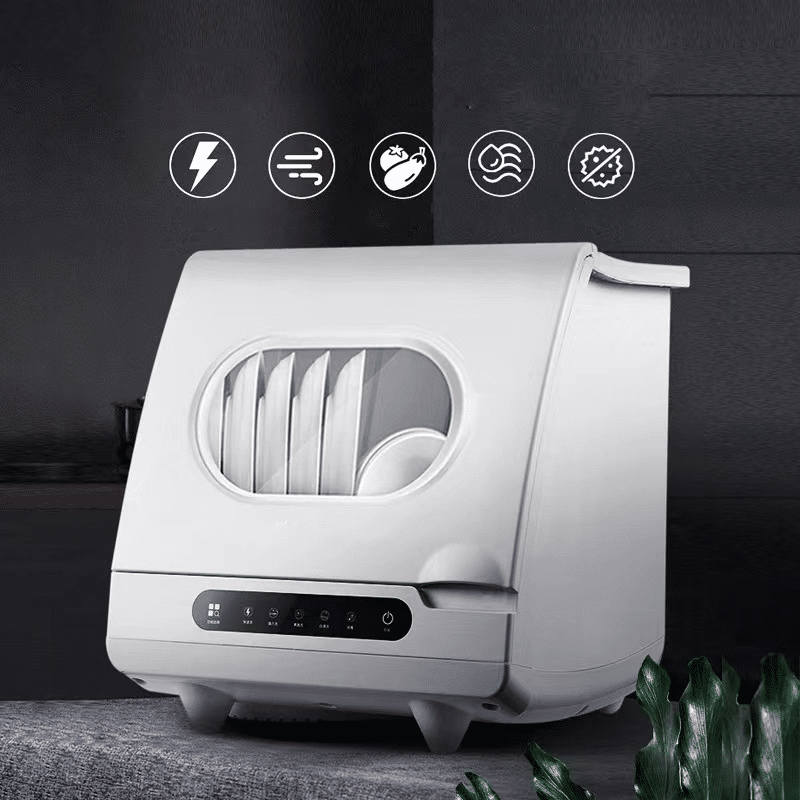On the dining table in the morning, the dark brown marks left by the coffee cup and the solidified oil on the fried egg plate were once a housewife’s nightmare. The smart dishwasher ten years ago required manual pre-washing, careful placement and amazing water consumption. Now, a smart dishwasher can analyze the water quality and turbidity in real time through multi-dimensional sensors, and automatically match the exclusive washing solution for different stains.
In Siemens lab, a baking tray covered with dried cheese is placed in a smart dishwasher. After the machine starts, it does not spray water immediately, but scans the surface components of the tableware through an infrared sensing system, then activates 80℃ micron steam for pre-treatment, and finally completes the cleaning with intelligent variable frequency water flow – the entire process saves 25% water compared to traditional models.
Technology Frontiers: Intelligent Leap from Perception to Decision
- AI Brain: The “Deep Thinker” in the Kitchen
The integration of Fangtai Healthy CookingGPT system and DeepSeek-R1 has built the industry’s first kitchen appliance center with reasoning capabilities. It has broken through the traditional instruction response mode and achieved three major upgrades:
Healthy personalization: By analyzing user health records, eating habits and other data, dynamically generate recipes that are accurate to 1g of seasoning, automatically recommend high-protein solutions for fitness people, and adjust folic acid intake for pregnant women
Full-link decision-making: From refrigerator food management (identifies the shelf life of ingredients and reminds), cooking plan generation, to air purification after cooking, forming a complete service closed loop
Knowledge empowerment: A knowledge graph built on 260 sets of food storage models, 380 sets of cooking skills and 6 million sets of healthy meal solutions makes AI recommendations both scientific and practical
- Hardware Revolution: Eye-brain-hand cooperation
At the AWE 2025 exhibition, Fangtai’s “hardware iron triangle” caused a sensation:
AI Intelligent Eye: Monitor temperature, oil smoke concentration, and food state in real time through multi-dimensional sensing, and even judge user’s movement proficiency
AI Genie: Incarnate as a voice interaction tutor, providing cooking navigation with scene understanding, and novices can also make Michelin-level dishes
3D Full-Sensory Robot Arm: Break through the dynamic control problem of Chinese cooking, and operate independently from cutting, stir-frying to cleaning. When it accurately senses the “pot steam” in the pot, it means that Chinese cooking has completed a historic leap from experience inheritance to data reconstruction
Casarte used the “Eye of AI” to overcome the pain points of traditional kitchens. Its anti-overflow technology monitors the status of the stove in real time through the camera, and AI automatically adjusts the firepower. After tens of thousands of hours of testing and testing of hundreds of pots, it achieves precise control of “boiling without overflowing”. Even if three pots are cooked together, it can be dealt with calmly.
Market change, consumer demand drives technology iteration
In 2025, the smart dishwasher market will show a trend of dual-track intelligence and scenario-based parallelism. According to Euromonitor Consulting data, Siemens has accounted for 40% of the high-end market with the highest sales record of 8 in 12 consecutive years. But local brands are overtaking through Chinese kitchen adaptation technology.

Market explosion: a dual-wheel drive of policy and demand
2025 has become the turning point for kitchen intelligence, and the two major engines are accelerating industrial upgrading:
Policy dividend release: The national “old for new” policy has expanded the subsidy category to 12 categories, and smart dishwashers and water purifiers have been shortlisted for the first time. Data from January to May 2025 showed that range hood sales surged by 37%, and newly subsidized dishwasher retail sales soared by 51%.
Consumer cognitive reconstruction: kitchens evolve from functional space to emotional connection places, and 68% of consumers are willing to pay a premium for local high-end technology. Fangtai Integrated Cooking Center has entered 3 million households in 6 years since its launch, confirming the consumption trend of “localization of high-end kitchen appliances”
The market potential is huge: the global smart kitchen appliance market size is expected to reach US$39.9 billion in 2027, with an annual compound growth rate of 19.1%, among which smart cookers have the fastest growth rate (20.2%). The Asia-Pacific region has become a growth engine, and China has contributed to the world’s largest market share due to the popularity of smart cookware and ovens.
When Casarti’s AI Eye accurately captures the moment when the soup pot boils slightly, and when Fangtai’s mechanical arm skillfully flips the wok to recreate the chef’s “warm spirit”, these scenes reveal not only technological breakthroughs, but also a revolution in the essence of the kitchen: from the labor field to the art of life, from tools to partners. As Fangtai Engineer said: “A true smart kitchen is not to let machines replace people, but to rediscover the joy of cooking and the temperature of love.

